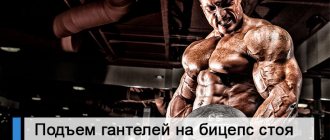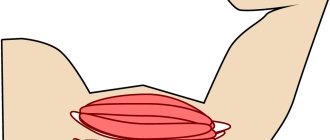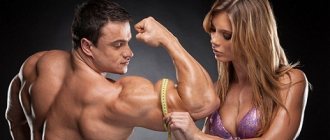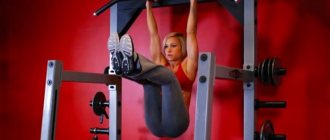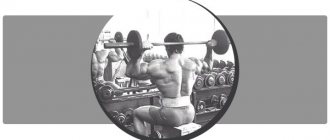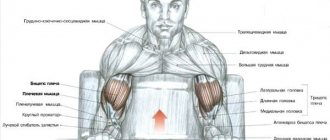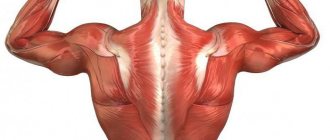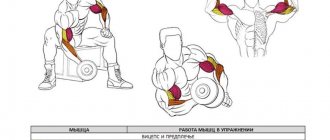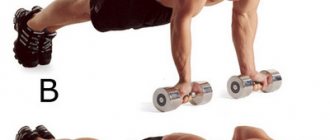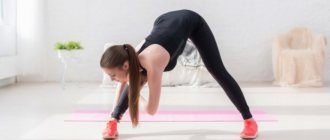Hello friends. Due to numerous requests on my VKontakte wall, the topic of today's meeting was chosen. In general, I followed your lead when making this topic. Today we will look at arm training (biceps and triceps). Although a lot has been written about hand muscles, unfortunately, even experienced trainers can rarely clearly explain the differences between certain exercises in terms of mechanics and effects on different parts of the muscle. Today we will remove the veil of misunderstanding from these topics.
When performing arm exercises (biceps or triceps), the pumper needs to solve two problems:
- Exclude other muscle groups from work as much as possible so that they do not steal the load (because of this, the muscles being trained can often lag behind). For example, a person trains his triceps with presses and push-ups, but only his chest grows. Classic situation.
- Learn to influence the necessary parts of the muscle (bundles). For example, almost always the outer triceps bundle is developed but the inner one is not. The situation is similar with the biceps.
The solution to both of these issues is within the competence of technology. It is her, our dear one, that we will study most of this lesson. Well, at the end we will talk about the nuances of creating training programs for maximum growth of arm muscles.
Triceps: structure, training features
Let's start with the triceps, because it is more important than the biceps in terms of size and number of bundles (heads).
The triceps is a “horseshoe-shaped” muscle consisting of three heads. All three heads narrow and pass into a common ligament, which is attached in the elbow area, so in any exercises that involve the triceps, ALL HEADS work at once! But the degree of this work will depend on the mechanics of the exercise, because the other edge of each of the three heads is attached in different places. Triceps:
- Lateral head (external);
- The long head (inner head) attaches to the back of the scapula and therefore requires the arm to be pulled back to be fully activated;
- The medial head (middle head or small ulnar head) is located next to the elbow and therefore does most of the work during slight extensions. Located between the outer (most part) and inner heads (hence the name - middle or medial). Very wide and very short therefore has a longer tendon, which we perceive as a cavity in the U-shape of the triceps.
The triceps “ligament” (which unites all the bundles) can be short or long. These are features of genetics. If such a ligament is short, then the triceps is longer and more massive. If the ligament is long, then the triceps is short and peaked.
Mesomorphs and endomorphs often have long and massive triceps, while ectomorphs often have short and peaked triceps. In the first case, the mass grows faster, and in the second case, the muscles look more aesthetically pleasing.
SECRET: with light loads (weights), most of the work is done by the middle (medial) head and to a small extent by the outer (lateral head), because the location of the middle head is most convenient - it is located closest to the elbow joint. In such a situation, the internal (long) head almost does not work.
But the greater the load you use in the exercise, the more the others, in addition to the middle head, are forced to engage: the outer and long (inner) heads.
I repeat once again: during arm extensions, all heads of the triceps work simultaneously! If you see very juicy “peak” triceps in one person, then this is largely due to his parents and not a specialized program. But how to develop existing muscles so that there are no failures? To do this, it is important to understand some nuances.
The degree of ease of engaging the triceps heads in the work:
- the middle (medial) head steals most of the load, especially in light movements;
- the external (lateral) head helps the middle one if the load increases;
- the internal (long) head turns on reluctantly and last of all if the load is large and you move your arm correctly (more on this below).
What does it mean to “retract your arm correctly”? The fact is that the long head is attached differently (to the blade) than the other two, so for its active operation several features are required. Failure to do so will lead to the lag of this part of the triceps. So…
Secret: to engage the long head of the triceps you need to:
- abduction of the arm upward (above the head). Exercises: French overhead presses;
- During extensions, engage the shoulder joint in the work. Exercise: for example, the French bench press of a barbell from behind the head, and not from the nose, i.e. our shoulder is under load;
- pressing the elbows to the body - shifts the load on the long head, spreading the elbows to the sides shifts the load on the outer head;
- Supination of the hand - shifts the load to the long head of the triceps, and pronation of the hand shifts the load to the outer head.
We recommend Underground 178. Low-catabolic training
While performing isolated exercises on any pushing muscle groups (triceps, chest, deltoids, quadriceps), you CANNOT CHEAT! Those. You can’t do jerks and pushes using other muscles to throw the weight.
Why? Because the work occurs in one joint at a fracture. Jerking in such a situation is 100% an injury sooner or later. By the way, this is why it is important to do isolated exercises after the basic ones (you are more warmed up and your joints are better prepared to work without injury). In general, I will tell you this, 50% of the injuries that I often see are variations of French presses with heavy weights! Those. any triceps exercises that involve work in only one joint (the elbow joint) are very dangerous.
RECOMMENDATION: load your triceps well with basic exercises (close-grip presses and parallel bars, first of all) and only after that you can do isolated exercises, because your triceps will already be tired and you will need lighter, and therefore less traumatic, weights to complete the workout.
The best exercises to train your triceps:
- Bench press with a narrow grip (upside down is even better);
- dips;
- French bench press (upside down);
- standing French barbell press (from behind the head);
- extension on a vertical block.
Sports biography of Julia Vince
In 2020, the athlete was invited to the Primeval Labs team. This is an American company specializing in sports nutrition and various hormones. Judging by information from fans, the girl began training in powerlifting in 2012. Always wears a medallion around his neck.
Strength indicators of Julia Vince:
- Squats – 202.5 kg;
- Deadlift – 165 kg;
- Bench press – 100 kg.
Julia also gained immense fame in Europe and the USA. However, reviews from the international community are more negative than positive. Mostly female.
Conflict in 2014 in Saratov.
In 2014, on March 27, a dangerous conflict broke out at the Russian powerlifting champion of the IPA federation. During the weigh-in before the tournament, a fight broke out, and Svetlana Smirnova decided to spray pepper spray in Yulia’s eyes. Although the girl had a stun gun with her for safety, she did not use it. The beginning of the conflict was verbal battles under the photo of Julia Vince.
AWPC World Championships 2014.
In 2014, a girl with a doll's face collected 440 kilograms. In the bench press she achieved the coveted 100 kilograms, in the squats – 175 and in the deadlift – 165 kilograms. In 2020, on January 28, she received the title of Master of Sports of the International Class in powerlifting with doping control in the AWPC federation.
Steroids and other sports supplements
Yulia denies that she takes anabolic drugs and other potent drugs. To improve her shape, she uses exclusively sports nutrition: omega 3, BCAA, amino acids, Animal Pak and fat burners. However, such a huge increase in muscle mass with impressive strength indicators is possible only with the use of pharmacology.
Biceps: structure, training features
The biceps consists of two heads (BI means two = biceps):
- long (long tendon but small muscle): sits on the outer part of the arm.
- short (short tendon, but large muscle): sits on the inside of the arm.
Both bundles are connected (the same garbage as with the triceps) into one biceps tendon next to the elbow joint. Since this tendon is attached slightly inward (to the side of the forearm), the biceps can not only bend the arm, but also turn the palm towards the thumb (supination).
Usually, most people do not have any problems with the development of the short (inner) head of the biceps, because... it grows from almost any bending. The problem usually lies in the development of the outer (long) head of the biceps. Why?
Anatomically, the long head is attached to the shoulder joint in the upper part; therefore, to actively influence the long head, YOU NEED TO PULL YOUR ELBOW BACK, because this will mechanically stretch it and make it work.
How to engage the long head of the biceps:
- the farther your elbows are behind your back, the more the outer biceps works;
- The more the elbows are brought forward, the more the internal biceps works. (Example: Scott Bench Curls);
- the narrower the grip, the more the external biceps bun works (not the best option, because with such a grip you will try to bring your elbows forward and engage the internal bun);
- The wider the grip, the more the internal beam works.
Brachialis (shoulder muscle)
A very important muscle that is located under the biceps and does most of the work (60-70%) in flexion. Yes..yes...it is this that will allow you to lift heavy weights in standing curls, and not the biceps at all. What's the point?
The point is that the brachialis is attached directly to the bone (and not from the side, like the biceps), so it does not participate in the rotation of the hand (in supination), thereby concentrating the work directly along the vector of flexion in the elbow joint. Hence the strength and size (which many people forget about). I always recommend lifting the barbell with a reverse grip or “hammer” curls as the second exercise because they specifically develop the brachialis.
The best exercises to train your biceps:
- Barbell curl
- Reverse grip barbell curl
- Hammer curls
- Lifting dumbbells while lying on a horizontal or inclined bench
- Lifting dumbbells with supination
Forearms
Literally before filming the story, I went to my VKontakte wall to find out what other questions concern you. It turned out not in vain. Many people are concerned about the question of how to pump up their forearm. You know, over many years I have already developed a clear formula for the relationship between the level of fitness in general and the development of the forearms. It sounds something like this:
The lower a person’s level of fitness, the more concerned he is about training the forearm and other small muscles.
Understand that if you are not involved in arm wrestling and your goal is purely muscle size (including forearms), then YOU DO NOT NEED SPECIAL EXERCISES for FOREARMS! It’s like in that notorious story about jeep wheels that you are trying to “stick” on a Zaporozhian car. There will be no growth in small groups until you achieve growth in large ones. Think about the growth of strength in large groups, and over time the little ones will have nowhere to go and will grow up on their own.
When performing any weighted arm curls (barbell lifting in particular), the forearm actively works. Regular barbell raises work the inner part of the forearm, while reverse-grip raises work the outer part of the forearm. Most professional bodybuilders never specifically train their forearms.
By the way, if your wrists get clogged before your biceps in barbell curls and thereby limit your achievements, then it makes sense for you to switch to a curved bar or do variations of the exercise with a parallel grip (this takes the load off your forearms).
We recommend Underground 82. Stabilizing muscles
But, if you are still concerned about how to train this small muscle group, then the main exercises for the forearm are:
For a powerful workout, comrade!
- barbell curls;
- bending with a barbell with a reverse grip;
- pronation and supination;
- squeezing the expander and other joys.
The most pumped up man in the world
Who is the strongest man in the world today?
It is almost impossible to answer this question unambiguously. Many athletes live up to this title. The most suitable candidate is professional bodybuilder Ronnie Coleman, 8-time winner of the international Mr. Olympia bodybuilding championship. Ronnie's real name is Ronald Dean Coleman. He was born on May 13, 1964. From early childhood, Coleman loved sports. He devoted every free moment to playing football, basketball and baseball. And already at the age of 12 he had an impressive torso, which led others to believe that the boy went to the gym. However, they were wrong; Ronnie didn’t even see the barbell. Only a little later he decided to exercise on sports equipment, but after entering the university he left the rocking chair.
Ronnie Coleman - the most pumped up man in the world
In 1986, Ronnie Coleman graduated from Granbling State University in America. He graduated with a degree in accounting. But during his training, the athlete did not give up football and training. He played for the university team. After receiving his diploma, the future record holder went to work as an accountant in a chain of fast food restaurants. But he didn’t last long in the position. Already in 1991, the sport took over the young man, and he decided to start a career as a professional bodybuilder. It is worth noting that Coleman worked as a police officer for some time and is now a reserve officer in the police of the Texas city of Arlington.
After numerous victories in competitions at the end of his career, in 2007, Ronnie took only fourth place at the Mr. Olympia competition. Immediately after such a defeat, the eight-time champion announced his decision to retire.
Ronnie Coleman - victories of the most pumped up man on the planet However, after two years, Ronnie Coleman changed his mind and decided to return back to bodybuilding. In 2010, he took part in the Mr. Olympia competition, but was unable to even qualify. However, the athlete did not despair, because his wife Christine Achkar and two daughters Jamelia and Valencia Daniel are waiting and supporting him at home.
It is worth noting that Ronnie Coleman’s weight during competitions is approximately 135 kilograms, and in the off-season - about 150 kilograms. The champion's height is 180 centimeters.
Sport is always good for health, but “big sport” is increasingly ruining it. However, no matter what sport and how you engage in it, the editors of “Find Out Everything” always wish you to remain in great shape and in a great mood. On the pages of our portal you can also read our article about the worst people in the world. Subscribe to our channel in Yandex.Zen
Proper training for big arms
Let's now talk about proper arm training, i.e. about how to organize an effective workout.
What prevents (what mistakes in training) the growth of arms?
- Stupid attempts to develop arms in isolation from the development of the rest of the muscle mass.
Often, new athletes stubbornly hammer “showy” muscles such as biceps or chest, forgetting about the back and legs. Remember: truly massive muscles are only possible on a truly massive body. Many beginner programs often don't include arm exercises at all because they don't provide as much mass as bench presses, rows, and squats. Moreover, when you achieve serious results in pressing and deadlifting, your arms will seriously increase in size, even if you do not train them.
- Lack of ability to feel muscle contraction of the biceps and triceps.
A person seems to be doing a biceps exercise, but his wrist or back gets sore. How is it treated? You need to learn to turn off non-essential muscles. “Bedtime Prayer” should help you. In addition, you need to monitor the correct technique and work with very light weights at the beginning.
- Too much work on the biceps for beginners.
Small muscles (like the biceps) are very easy to overtrain with too much work. This is what is constantly happening around. It is not advisable to do more than 8 working approaches for biceps. Exceptions for those experienced or using anabolic steroids. It is necessary to increase the number of working approaches extremely carefully and not earlier than a couple of years after the start of classes. Otherwise, you will “stretch” your biceps and it will not think about how to become stronger and bigger, but about how not to die during the next workout (it will develop endurance adaptation instead of strength adaptation). Or, even worse, you will drive your hands into a stable “plateau” state where all growth stops.
- No progression of loads when working on biceps and triceps.
The muscles of the arm follow the same rules as the rest. To grow, they need increased loads. If it is not there, then there is no muscle growth. The problem is that most arm exercises are isolated and constantly progressing is difficult and anatomically dangerous. Exit? Make a base! Instead of dangerous variations of the French press, do a lot of close-grip bench presses and parallel bars, train your back with serious rows (this will also stimulate your biceps), use the most “strong” exercises to train your biceps (standing barbell raises, “hammer” curls). And try to track and progress the load. Arnold had a terrible cheat, but did barbell curls with a weight of 120 kg. This explains the incredible size of his biceps at that time.
Complexes in the arm muscle training program
There are more variations of this arrangement than there are rice in China. Each method has its PROS and CONS. Popular SPLIT SCHEMES:
Back + Biceps………Chest (or deltoids) + Triceps.
Advantages: on one day you load the entire pushing or bench press group at once and on all other days it COMPLETELY RESTS and grows. Disadvantages: after training the “big brother”, the little one is too tired for serious exercise. After bent over rows and pull-ups, you won’t be able to lift your usual heavy weights on your biceps.
Back + Triceps…..Chest + Biceps.
Here everything has changed places for us. Advantages: The little one doesn't care how the big brother from the other family trained, so he's fresh and can do the hard work. Disadvantages: fewer full days for a specific group to relax. Let's say you trained your biceps with your chest today, and tomorrow you go to train your back. During training, the load will AGAIN be partially placed on the biceps (i.e., instead of resting, it works again the next day). However, I like this (second method of combining) much more than the first.
Biceps+Triceps…
From my point of view, the best way to properly train your arms. Disadvantages: you will need one more extra day (training) in order to work on your hands like this. The benefits are obvious - fresh biceps and fresh triceps can be actively worked.
What training techniques can be used to train arm muscles?
There are a huge number of techniques or principles and any can be easily integrated into manual training, but it is worth remembering that the arm muscles are SMALL and they are very easy to kill with heavy load. Yes, weight drops, forced and negative reps, giant sets... all this will work great... but it can also kill your biceps for the next month. Therefore, we will use only one principle - SUPER SERIES. And not in the version that Uncle Joe recommends, but in the version that I recommend, because it is less expensive.
Super series are when you perform two exercises in a row (without rest) on opposing muscles (antagonists). For example: a set of barbell curls for biceps followed immediately by a set of triceps extensions. This is the classic Uncle Joe method. For beginners it can be very difficult and energy-intensive, so we WILL REST!
We recommend Underground 204. When will the judgment day of humanity: skynet vs homo
In other words, we alternate between working on the biceps and working on the triceps, taking regular rest between approaches (i.e. not immediately).
You can alternate work in two ways:
- alternate sets of exercises (biceps set...rest 45-60 seconds...triceps set...)
- alternate the exercises themselves (4 sets of biceps exercises... 4 sets of triceps exercises...)
WHY DOES THIS WORK GOOD?
The fact is that we kill two birds with one stone with this scheme. We rest after contracting the biceps a little more than usual and thereby restore strength in it a little more than usual, on the one hand. And during this time we do not cool down (because we passively influence him during the training of the antagonist), on the other hand. Those. and our muscles are stronger and the amount of work is large. Usually, in order to show strength, we have to rest more and reduce the amount of work during training.
In addition, by training your triceps, you actively restore your biceps. Because it is actively supplied with blood and “massaged” like any antagonist during operation. As a result, the biceps not only recovers, but recovers better and faster than if you had sat without moving all this time (rested passively).
Well, the last, important point: PUMPING. Which constantly increases and does not allow your muscles to cool down. Pumping has a lot of useful properties: it promotes, for example, the growth of slow muscle fibers (I’ll make a story about this anyway), it also promotes the delivery of nutrients and activates growth factors, improves capillarization and the appearance of the muscle, and much more...
If you do two exercises in a row for antagonist muscles, what should you train first: biceps or triceps?
Often many gurus give clear answers on this matter. This is not true. In bodybuilding, there are no 100% valid schemes at all times and on all schemes. Let me explain with our example.
Usually you need to START WITH BICEPS EXERCISES and then do triceps. The fact is that if you change this sequence and do the triceps first, then the residual tension will limit you in the maximum contraction of the biceps after. This is a theory. In practice, it is possible that this “limitation” of biceps work will be exactly what you need in order to give the muscle a new (unfamiliar) stress for subsequent growth. Conclusion: beginners do biceps exercises, then train triceps, and experienced ones look at the situation.
Constant tension in the mid range of the biceps curl
One of the fundamental concepts of muscle physiology is the tension/length ratio, which means how much force a muscle can generate depending on its length (Figure 1).
As you can see from the diagram below, muscles have their lowest strength potential when they are fully stretched or fully contracted.
As I said before, muscles tend to produce the maximum possible force in the middle - halfway through the range of motion (i.e., the middle of the range). At this point, the muscles are able to activate the highest percentage of motor neurons (the nerve cell and the set of muscle fibers that it activates) .
Simply put, activating more motor neurons means you can recruit more muscles with each repetition if the force applied is high enough, as shown in the following graph (Figure 2).
Now that you understand that muscles produce the most force in the middle of the range of motion, where they also have the potential to activate the highest percentage of motor neurons, you can appreciate these fundamentals and put exercise theory into practice. What we call Constant Tension in the Mid Range Biceps Curl ( MRBC ).
Instead of doing a full range of biceps curls (standing with dumbbells, or with a curved barbell), we start with the elbow bent at 90 degrees (i.e. in the middle) and perform repetitions of partial curls in the middle of the range.
In other words, in relation to your elbows, you are performing bicep curls without ever fully reaching the bottom or top of the range of motion.
We prefer to perform our PNSDB program by prioritizing time over reps. Because it doesn't matter how fast you move because you are constantly under tension, and using a calculated interval will ensure that no matter the tempo at which each mid-range curl is performed, you will achieve the desired time (40-60 seconds) under tension.
Conclusion
The traditional biceps workouts we all know and love are still as great and effective as ever. While we embrace the wisdom of the old school, we also use some new programs that you can now add to your own biceps training toolkit.
Another useful article on BODY-ZONE.ru “Biceps: Arnold Schwarzenegger’s technique”
Translation from English of Nick Tumminello’s article “5 Tips for Bigger Biceps” from Arnold Schwarzenegger’s official website schwarzenegger.com .
Sequence of exercises for arm muscles
I have already spoken about this many times. There is even a video on this topic. In short, we always start with heavier exercises (basic) and end with lighter ones.
For triceps, the main basic exercises are:
- close grip bench press;
- bars
Minor:
- French bench press;
- standing overhead French press;
- extension at a vertical block;
For biceps, the main “conditionally basic” ones are:
- standing biceps curl;
- lifting the barbell for biceps with a reverse grip;
- “hammer” curls with dumbbells.
Minor:
- lifting dumbbells for biceps while sitting or lying down;
- Larry Scott bench;
- concentrated lifts.
An effective program for arm muscles is drawn as follows:
- basic biceps size 2 + 3-4 x 6-12;
- basic triceps size 2 + 3-4 x 6-12;
- basic biceps 3-4 x 6-12;
- basic triceps 3-4 x 6-12;
Or, advanced level:
- basic biceps size 2 + 3-4 x 6-12;
- basic triceps size 2 + 3-4 x 6-12;
- basic (or isolated) for biceps 3-4 x 6-12;
- basic (or isolated) for triceps 3-4 x 6-12;
- isolated for biceps 3-4 x 6-12;
- isolated on triceps 3-4 x 6-12.
Specific example:
- standing biceps curl 2 sizes + 3-4 x 6-12;
- bench press with a narrow grip, size 2 + 3-4 x 6-12;
- “hammer” with dumbbells standing 3-4 x 6-12;
- Dips (triceps) 3-4 x 6-12.
Or, for the experienced
- standing biceps curl 2 sizes + 3-4 x 6-12;
- close grip bench press size 2 + 3-4 x 6-12;
- lifting the barbell with a reverse grip 3-4 x 6-12;
- French overhead press standing 3-4 x 6-12;
- lifting dumbbells for biceps lying-sitting (elbows back) 3-4 x 6-12;
- Extension at the vertical block is 3-4 x 6-12.
